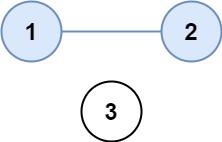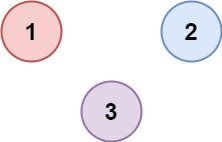There are n cities. Some of them are connected, while some are not. If city a is connected directly with city b, and city b is connected directly with city c, then city a is connected indirectly with city c.
A province is a group of directly or indirectly connected cities and no other cities outside of the group.
You are given an n x n matrix isConnected where isConnected[i][j] = 1 if the ith city and the jth city are directly connected, and isConnected[i][j] = 0 otherwise.
Return the total number of provinces.
Examples:
Input: isConnected = [[1,1,0],[1,1,0],[0,0,1]]
Output: 2
Input: isConnected = [[1,0,0],[0,1,0],[0,0,1]]
Output: 3
强连通分量个数问题
c++
class Solution {
private:
int WHITE = 0, GRAY = 1, BLACK = 2;
public:
vector<vector<int>> GraphConstruction(vector<vector<int>>& edges){
vector<vector<int>> Graph(edges.size()+1, vector<int>());
for(int i = 0; i < edges.size(); i++){
vector<int> vertex = edges[i];
for (int j = 0; j < vertex.size(); j++)
if (i != j && vertex[j] == 1)
Graph[i+1].push_back(j+1);
}
return Graph;
}
vector<vector<int>> ReverseGraph(vector<vector<int>>& Graph){
int n = Graph.size();
vector<vector<int>> GraphR(n, vector<int>());
for(int src = 1; src < n; src++){
vector<int> vertex = Graph[src];
for (const int& dst : vertex){
GraphR[dst].push_back(src);
}
}
return GraphR;
}
void DFS(vector<vector<int>>& Graph, int root, vector<int>& color, vector<int>& DFS_Sequence){
color[root] = GRAY;
for (const auto& node : Graph[root])
if (color[node] == WHITE)
DFS(Graph, node, color, DFS_Sequence);
color[root] = BLACK;
DFS_Sequence.push_back(root);
}
vector<int> DFSVisit(vector<vector<int>>& Graph){
int n = Graph.size();
vector<int> color(n, WHITE);
vector<int> DFS_Sequence;
for (int i = 1; i < Graph.size(); i++)
if (color[i] == WHITE)
DFS(Graph, i, color, DFS_Sequence);
return DFS_Sequence;
}
vector<vector<int>> getSCCs(vector<vector<int>>& Graph, vector<int>& Sequence){
int n = Graph.size();
vector<int> color(n, WHITE);
vector<vector<int>> SCCs;
for (int i = 1; i < n; i++){
int vertex = Sequence[i-1];
if (color[vertex] == WHITE){
vector<int> DFS_Sequence;
DFS(Graph, vertex, color, DFS_Sequence);
SCCs.push_back(DFS_Sequence);
}
}
return SCCs;
}
int findCircleNum(vector<vector<int>>& isConnected) {
vector<vector<int>> Graph, GraphR, SCCs;
vector<int> Sequence;
Graph = GraphConstruction(isConnected);
GraphR = ReverseGraph(Graph);
Sequence = DFSVisit(GraphR);
reverse(Sequence.begin(), Sequence.end());
SCCs = getSCCs(Graph, Sequence);
return SCCs.size();
}
};执行用时:24 ms, 在所有 C++ 提交中击败了81.93%的用户
内存消耗:17.3 MB, 在所有 C++ 提交中击败了5.01%的用户
class Solution {
private:
int WHITE = 0, GRAY = 1, BLACK = 2;
public:
vector<vector<int>> GraphConstruction(vector<vector<int>>& edges){
vector<vector<int>> Graph(edges.size()+1, vector<int>());
for(int i = 0; i < edges.size(); i++) {
vector<int> vertex = edges[i];
for (int j = 0; j < vertex.size(); j++)
if (i != j && vertex[j] == 1)
Graph[i+1].push_back(j+1);
}
return Graph;
}
void DFS(vector<vector<int>>& Graph, int root, vector<int>& color){
color[root] = GRAY;
for (const int& node : Graph[root])
if (color[node] == WHITE)
DFS(Graph, node, color);
color[root] = BLACK;
}
int DFSVisit(vector<vector<int>>& Graph){
int num = 0, n = Graph.size();
vector<int> color(n, WHITE);
for (int i = 1; i < n; i++)
if (color[i] == WHITE){
num++;
DFS(Graph, i, color);
}
return num;
}
int findCircleNum(vector<vector<int>>& isConnected) {
vector<vector<int>> Graph = GraphConstruction(isConnected);
return DFSVisit(Graph);
}
};执行用时:24 ms, 在所有 C++ 提交中击败了81.93%的用户
内存消耗:15.6 MB, 在所有 C++ 提交中击败了5.01%的用户
class Solution {
private:
int num = 0;
vector<int> height, parent, keys;
public:
void Create_Set(int x){
if (parent[x] != 0) return;
parent[x] = x;
height[x] = 1;
}
int Find_Set(int x){
while(parent[x] != x)
x = parent[x];
return x;
}
void Union(int x, int y){
int ROOT1 = Find_Set(x);
int ROOT2 = Find_Set(y);
if (ROOT1 == ROOT2)
return;
if (height[ROOT1] <= height[ROOT2]) {
if (height[ROOT1] == height[ROOT2])
height[ROOT2]++;
parent[ROOT1] = ROOT2;
}
else
parent[ROOT2] = ROOT1;
}
int findCircleNum(vector<vector<int>>& isConnected) {
parent.resize(isConnected.size()+1);
height.resize(isConnected.size()+1);
for (int i = 0; i < isConnected.size(); i++){
for (int j = 0; j < isConnected.size(); j++){
if (isConnected[i][j]){
Create_Set(i+1);
Create_Set(j+1);
Union(i+1, j+1);
}
}
}
for (const int& x : parent) {
int key = Find_Set(x);
if (key != 0) {
if (find(keys.begin(), keys.end(), key) == keys.end()) {
num++;
keys.push_back(key);
}
}
}
return num;
}
};执行用时:24 ms, 在所有 C++ 提交中击败了81.93%的用户
内存消耗:13.4 MB, 在所有 C++ 提交中击败了42.50%的用户
Attention
- union的时候如果key一样或setID一样则return
- keyID避免用0,使用i+1作为keyID
- 查看有集合集合的时候要推到集合id

